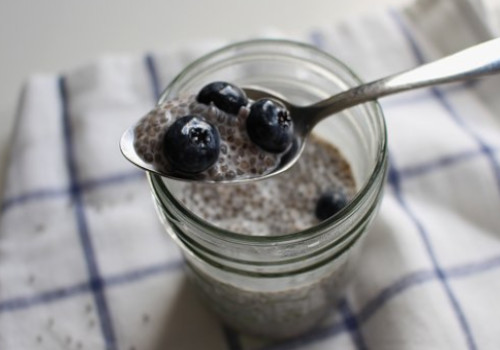Chia Seeds Recipes: How to Eat Chia Seeds for Weight Loss

Have you been trying hard to lose some extra kilos and yet not successful? Don’t worry; the good few is that many superfoods can help you achieve your ideal weight pretty quickly.
Did you know how to eat chia seeds for weight loss? Chia seeds have been trendy for their excellent nutritional benefits. The high fibre content in chia seeds can help you reduce the stubborn belly fat. The best part is that they are very affordable, highly nutritious, and add flavour to any dish.
These small seeds are abundant in polyunsaturated fatty acids and proteins as well. You can add chia seeds to your diet in multiple ways to lose weight quickly.
Research suggests that the most suitable time to eat chia seeds for weight loss is before the first and last meals of the day.
These powerful seeds are rich in antioxidants, healthy fats, and fibre that can help you flush out toxins from the body, reduce inflammation, and keep you full for a longer time.
Nutritional Properties of Chia seeds
Chia seeds are rich in-
- Copper
- Dietary Fiber
- Omega-6-fatty acids
- Omega-3-fatty acids
- Calcium
- Sodium
- Protein
- Phosphorus
- Zinc
- Manganese
As per your preference, you can incorporate chia seeds with your daily diet to get benefits. You can add chia seeds to your food in different ways, such as:
- Grounded chia seeds
- Soaked chia seeds
- Chia seeds in oil form
How to Eat Chia Seeds for Weight Loss
Let’s have a quick look at how you can use Chia seeds in different ways to lose weight fast (Chia seeds weight loss recipes).
1. Chia Seeds with your Favorite Salad

Love eating chia seeds? You can make your salad even better by adding some chia seeds to your fresh fruits. It is the best way to eat chia seeds.
With all its nutritional benefits, you will feel energized all day and also fuller. In this way, you can lose weight with chia seeds.
2. Chia Seeds Smoothie

Love smoothies? If yes, then you make your smoothie even more satisfying, with chia seeds.
You can make your smoothie and give it a healthy twist by adding some chia seeds into it.
Ingredient
- Some blueberries
- One banana
- 1-2 tablespoons of chia seeds
- Low-fat milk
Instructions
- Peel off the banana and add it to your smoothie maker
- Now add the blueberries, chia seeds, and milk
- Blend it and pour in a glass to drink freshly
Note- You can also add yoghurt instead of milk and a little honey for better taste, which is completely optional.
Don’t miss: Benefits of coriander seeds soaked in water
3. Chia Seeds Pudding Recipe

While many people think that chia seeds can only be used as a topping, it can also be used as the main ingredient for cooking.
Chia pudding is undoubtedly one of the tastiest ways to use this incredible superfood for all its benefits.
Ingredients
- 2 cups of low-fat milk
- 2-3 cups of chia seeds
- Half tablespoon of vanilla extract
- Some raisins
- 2 tablespoons of honey
- 2 tablespoons of dried coconut powder
Instructions
- Combine milk, honey, chia seeds, and vanilla extract in a bowl.
- Allow it to sit for 15 minutes.
- Stir the mixture and cover the bowl securely with a plastic wrap
- Now refrigerate it overnight.
- The next day, add raisins and coconut powder as a topping and enjoy!
4. Iced Tea with Chia Seeds: ( Chia and Lemon)
How to eat chia seeds for weight loss? With this recipe, you can lose weight easily.
Ingredients
- 2-3 tablespoons of chia seeds
- 1 tablespoon of green tea
- 1 tablespoon of lime juice
- 1 tablespoon of organic honey
- Ice cubes
- Water
Instructions
- Soak the chia seeds in water for 1-2 hours
- Boil one cup of water in a pan and once it starts boiling, switch off the heat.
- Now add the green tea to the hot water.
- Allow it to steep for 2-3 minutes
- Let it cool for a while and then refrigerate for half an hour
- Now add the chia seeds, honey, lime juice, and some ice cubes into your tea
- Relish this delicious drink in the summers for benefits of chia seeds for weight loss.
5. Chia Seeds Oatmeal
For a quick and on-go breakfast, try this delicious oatmeal recipe, which will make you feel fuller throughout the day and let you shed a few kilos.
Ingredients
- Half cup of milk
- ¼ cups of rolled oats
- ¼ cup of Greek yogurt
- 2 tablespoons of chia seeds
- 2 tablespoons of honey
- A pinch of cinnamon powder
- Few blueberries
Instructions
- Mix milk, Greek yogurt, chia seeds, honey, and cinnamon in a small jar with a lid.
- Shake it well to mix it properly
- Remove the lid and add some blueberries
- Now close the lid and refrigerate for at least 8 hours
- This is Best recipes for chia seeds to lose weight.
Note- You can also add other fruits like peaches and a different variety of berries.
Take a look at this article: Almond and fennel for eyes
6. Spinach Kale Shake
While you are trying to lose weight, it is vital that you consume the right amount of veggies in your diet and what can be better than a vegetable shake.
You can add any green vegetable of your choice with chia seeds.
How do you eat chia seeds? Here is a recipe for a nutritious shake with spinach, kale, and chia seeds.
Ingredients
- 2 cups of fresh spinach
- 1 cup of almond milk
- 1 leaf of kale
- 1 tablespoon of chia seeds
- 1 banana
Instruction
- Blend the spinach, chia seeds, kale leaf with the almond milk
- Once the mixture is smooth, add some banana and blend again
- Drink fresh
- Best Chia seed drink for weight loss.
7. Quinoa Chia Salad
Ingredients
- 2 tablespoons of chia seeds
- Half cup of quinoa
- ¼ cup of red bell pepper chopped
- ¼ cup of green bell pepper chopped
- ½ kale-chopped
- 1 tablespoon of fresh lime juice
- ½ tablespoon of black pepper powder
- 1 tablespoon of olive oil
- Salt
Instructions
- Cook quinoa in a pan for some time.
- Add all chopped vegetables in a bowl along with chia seeds, lime juice, black pepper, olive oil, and salt.
- Mix thoroughly and spread it over the cooked quinoa
- Mix it again and enjoy the salad!
This list is not exhaustive; you can enjoy many other chia seeds recipes; however, the ones listed here will surely give you the nutritional boost and weight loss. Chia seeds are very effective weight loss boosters.
We hope you’ve enjoyed this article on chia seeds recipes and how to eat chia seeds for weight loss.





